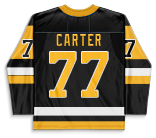
NHL Scratches & Line Changes



McAvoy was suspended for four games following a hit to the head on October 30th but he's eligible to return to the lineup vs. Montreal. McAvoy was back on the top power-play unit in Friday's practice and enters play with eight points (2G / 6A) in nine games this season.

Lindblom will finally get the chance to make his season debut in place of Anthony Duclair, who will miss Friday's game with an undisclosed injury. Lindblom was limited to six goals and nine assists across 73 games with the Sharks last season. He'll begin Friday's game skating alongside Nico Sturm and Kevin Labanc on the Sharks' third line.

After recording nine points (3G / 6A) in his first seven games as a Red Wing, Gostisbehere went invisible, recording zero points and a -8 plus/minute rating in his last six contests, leading to his eventual healthy scratch on Thursday. He will return to the lineup on Saturday against the Columbus Blue Jackets.

DeAngelo has played all 13 games for the Hurricanes this season, including playing 15:17 and scoring his first goal in his most recent outing, but will be a healthy scratch on Friday against the Florida Panthers. DeAngelo's scratch likely indicates that Brett Pesce (lower-body) will be returning to the Hurricanes lineup.

Reilly played his first two games of the season with Uvis Balinskis being a healthy scratch, recording seven shots on goal and a -2 plus/minus rating in the two contests. Reilly will return to the pressbox with Balinskis drawing back into the Panthers' lineup.

Balinskis has played 10 games for the Panthers but has been scratched in their two most recent contests in favour of Mike Reilly. Balinskis, who has zero points while averaging 14:07 time-on-ice, will return to the third defensive pair with Josh Mahura.

Boyd has yet to score this season but has three assists, nine SOG, two PIMs and a -1 plus/minus in seven games played but will be a healthy scratch Thursday as Jason Zucker (lower body) makes his Coyotes' debut. Boyd is in this seventh NHL season and will hope to be back in the Coyotes' lineup sooner rather than later.

MacEwen has an assist, two SOG and five PIMs through four games in 2023-24 but will be the odd man out of the Senators' roster as he is a healthy scratch Thursday vs. Vancouver. The 27-year-old bruising right-winger will be replaced by Matthew Highmore, who was brought in from Belleville (AHL) to help kill penalties.

Savoie is one of the Sabres' most intriguing prospects after being draft as a first-round pick of the 2022 NHL Draft (9th overall) and is set to make his debut Friday vs. Minnesota. The 19-year-old centre appeared for five games for Rochester (AHL) earlier this season and had two goals, three assists, and six PIMs in six games played.

Peohling has an assist, 10 SOG, two PIMs and a -2 plus/minus through 11 games so far in 2023-24 but will be the odd man out of the Flyers' lineup Friday vs. Anaheim. The 24-year-old centre will give way to Morgan Frost, who has been a healthy scratch for the Flyers previous two games.

Frost was a healthy scratch for the Flyers' loss to San Jose Tuesday but is expected to draw back into the lineup Friday vs. Anaheim after taking line rushes with Owen Tippett and Travis Konecny Thursday. The 24-year-old centre led the Flyers in even-strength points in 2022-23 but has yet to get a point through six games in 2023-24 and has only eight SOG and a +1 plus/minus.

Carter has been a healthy scratch for the Penguins' last two games but will draw back into the lineup Thursday vs. Los Angeles. The 19-year-old veteran has been held pointless so far through nine games in 2023-24, but has seven SOG, two PIMs and a -1 plus/minus. Vinnie Hinostroza has been sent down to Wilkes-Barre/Scranton (AHL) in a corresponding move.

Winterton was recalled from Coachella Valley (AHL) for the first time in his career and will make his NHL debut Thursday vs. Colorado. The 20-year-old forward was Seattle's 2021 third-round pick (67th overall) and had three goals, five points, and a +4 plus/minus in seven games with Coachella Valley prior to his promotion.

With Jordan Eberle (cut by skate) day-to-day, Wright finds his way into the Kraken's lineup for the first time this season Thursday vs. Colorado after being recalled from Coachella Valley (AHL) earlier in the day. The 19-year-old made his NHL debut last season and had a goal, an assist, four SOG, two PIMs and a +4 plus/minus in eight games prior to being sent back to junior. In seven games prior to his promotion, he had four goals and six points with Coachella Valley.

Addison was acquired by Sharks for a 2026 fifth-round pick and Adam Raska and will make his San Jose debut Thursday vs. Edmonton. The 23-year-old defensemen was spotted on the Sharks' top power play at morning skate and will hope to add to the five assists, 18 SOG, six PIMs and -3 plus/minus he had through 12 games with Minnesota already in 2023-24.

Reaves has played all 13 games for the Maple Leafs, going without a point, and racking up a -9 plus/minus rating while averaging 7:46 time-on-ice. Reaves joins John Klingberg as high-profile offseason signings that are expected to be healthy scratches on Friday. The Maple Leafs recalled Pontus Holmberg from the Marlies (AHL), who will be a possibility to slot into the lineup.

Tufte is expected to play his second game of the season for the Avalanche on Thursday when they take on the Seattle Kraken. In his only game this season, Tufte was held without a point but took four shots on goal in 11:28 time-on-ice.
